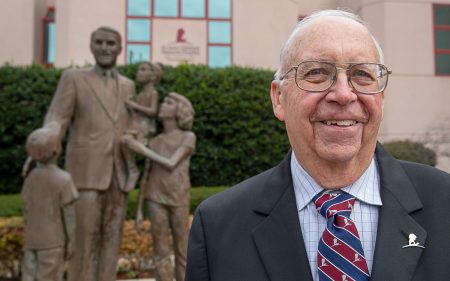
Paul Williams: Architect to Stars and St. Jude
African-American architect who made his name designing homes for the stars donated his star-shaped design for the hospital founded by his friend Danny Thomas.

February 20, 2019 • 6 min

He styled a Mid-Century Modern bachelor’s abode for Frank Sinatra that enthralled a national audience during a televised tour. For Lucille Ball and Desi Arnaz, he designed a Palm Springs weekend home that epitomized sleek, glass-walled elegance.
But Paul Revere Williams had something simpler, more functional in mind when he drew up plans for the original St. Jude Children’s Research Hospital.
For this project, the so-called architect to the stars sketched a star.
With five wings radiating like spokes from a central hub, the first St. Jude building served thousands of patients during the hospital’s formative period. It accommodated groundbreaking research that produced the first major advances in treating leukemia and other previously incurable childhood diseases.

That star-shaped hospital, to be sure, lacked the grandeur and renown of other designs by the architect. However, noting the vital, life-saving work conducted within St. Jude’s walls, Williams would later call the project the most satisfying of his highly acclaimed career.
The satisfaction was nothing if not reciprocal. Among all the contributions that transformed St. Jude from a quixotic dream into concrete-and-steel reality, few were as significant as the one made by the brilliant, yet humble African-American architect who donated his services to help his friend and St. Jude founder Danny Thomas get the hospital built.
Orphaned at an early age
He may have been born in California and devoted most of his career to projects along the West Coast, but Williams’ ties to Memphis ran deep. His parents hailed from the city, where his father served as a waiter at the old Peabody Hotel.
The humid Memphis climate proved less than accommodating, however. Both parents contracted tuberculosis and fled, along with their eldest son, to the drier, sunnier weather of Los Angeles in 1893, a year before Paul’s birth.
Good fortune did not accompany them. Paul’s parents were both dead from the illness before he turned 4, leaving him and his brother orphans to be sent to separate foster homes.
Williams nonetheless thrived amid the multi-ethnic environment of Southern California and the guidance of a foster mother who valued education and supported his interests. “She encouraged anything he did,” says Williams’ granddaughter, Karen E. Hudson, who has studied the architect’s notes and written books about him.
In the early 1920s, after studying architecture in art schools and college and then working for others in the profession, Williams opened his own office and became the first African-American member of the American Institute of Architects.
Over the next half-century, Williams’ high-profile commercial and government projects, as well as his designs for residential clients that included movie stars and business and entertainment moguls “sort of shaped the collective memory of a region within our country,” said Daisy-O’Lice Williams, an associate professor of architecture at the University of Oregon who is not related to Paul.
The architect was able to transcend racial barriers that forced him to accept lower fees than his white counterparts and then build an unusually successful and long-lived practice. “He was a shrewd businessman. He knew how to read clients,” Williams said.
Reading clients, however, also meant he had to tread carefully amid the unenlightened racial attitudes of the day. Knowing that some clients were uncomfortable sitting next to a black man, the architect learned to draw upside down so he could sit across from them during consultations.
“Basically, he knew the tenor of the time, and if he wanted to get jobs he said he had to use tricks, and that was one of them,” his granddaughter said.
He used a number of other tricks to win over hesitant clients. “If they came in and saw him and then kind of wanted to back out he’d say, ‘Well how much are you going to spend on your home?’ It’s the early Twenties, and if they said $8,000, he’d say, well, I’m sorry, I make it a point not to take any jobs for under $10,000.’ And then, they’re like, ‘Ok, maybe we’ll listen.’”
Williams had to take similar care when visiting construction projects.
“When he went to a job site, he always had his hands behind his back, because it was an affront for a black man to shake hands with a white person,” said Lee Askew, founder of the Memphis firm ANF Architects and member of a committee that organized the Paul R. Williams Project. The project, a collaboration of the Memphis chapter of the AIA and the Art Museum of the University of Memphis, compiled a retrospective of the architect’s life and career.
The St. Jude project
Williams might not have come to Memphis, his ancestral hometown, were it not for one of his famous Hollywood clients.
“He had known Danny Thomas for a very long time. He had renovated their home…,” said Leslie Luebbers, director of the U of M art museum and the Paul R. Williams Project. “They were quite good friends.”

St. Jude founder Danny Thomas with Paul Williams, the architect who donated the plans for the original hospital.
Not only were they friends, they shared a common passion, Williams’ granddaughter said. “They used to sit around and talk about their joint vision for children – my grandfather as an orphan, and Danny Thomas caring so much about the health of children.”
A March 1954 article in Jet magazine reported that Williams would donate his services in designing St. Jude, which would be open to people of all races and creeds. The architect submitted several renderings for use in fundraising, including one that, to Thomas, evoked the five-sided star that was the symbol of St. Jude Thaddeus, the patron saint of hopeless causes and the inspiration for the hospital.
Thomas was delighted. “Some people call this a nice coincidence,” the hospital founder said at the time. “I call it the hand of God pushing Williams’ pencil.”
Hudson said her grandfather actually had another star in mind. He had a dream about a building in the shape of the Star of David. In that respect, she said, the drawing resembled stars that both Thomas and Williams believed in.
In the final design, Luebbers sees consistencies with Williams’ other projects. The architect liked to use circles and angled wings to let in as much light as possible.
A hub-and-spoke design especially made sense for a children’s hospital, Luebbers said, given that the traditional methods of treating sick kids involved sunlight and fresh air. It also was a common design for the sanitoria housing patients stricken with tuberculosis — the disease that had killed both of Williams’ parents.
“In some ways, that star design was natural to him, his design philosophy…,” Luebbers said. “He wanted to make it as light and airy as possible for very sick children.”
The final blueprints showed the hub housing the outpatient department, staff offices, record rooms, blood bank, admitting office, medical library, assembly rooms for meetings, schoolrooms for kids in treatment, and administrative offices.
The various wings contained inpatient rooms for 38 children, dining and kitchen facilities, as well as X-ray equipment, clinical labs and research offices.
In one notable change to the original plans, Dr. Donald Pinkel, the hospital’s first medical director, eliminated the proposed surgical wing, opting instead to arrange for the use of surgical facilities at neighboring St. Joseph Hospital. The repurposed wing would become the third dedicated to laboratories.
A lasting legacy
The hospital that Williams designed opened February 4, 1962, having cost about $3.5 million to construct and $2.5 million to equip. During dedication ceremonies that day, Thomas mentioned Williams’ involvement as an example of St. Jude’s race-blind, multicultural mission.
The hospital accommodated rapid growth during its early years. At a 1972 dinner in Memphis honoring Williams for the design work he and his firm donated to St. Jude, Pinkel praised the architect for having the vision to leave “vast amounts” of open space allowing for research facilities to be arranged as needed.

Paul Williams is shown seated between his daughter, Marilyn Williams Hudson, and St. Jude founder Danny Thomas.
“He was able to foresee that any great research institution must always be changing to meet the needs of the people it serves.”
Williams, for his part, was quoted in local newspapers as saying St. Jude was his most satisfying building because of the work conducted within it.
He retired a year after the dinner and died in 1980 at age 85. Thomas — the longtime friend with whom Williams shared a dream to help children — delivered a eulogy at his funeral.
Hudson says architecture alone does not define her grandfather. “Above anything else, he was always a gentleman, and he was a gentle man with a dream.”
Nearly four decades after Williams’ death, the AIA named him the first African-American recipient of its Gold Medal. The institute cited his portfolio of nearly 3,000 buildings and his “lasting influence on the theory and practice of architecture.”
The original hospital stood for 30 years, falling to demolition crews in 1992 to make way for the new Patient Care Center. An inscription on a wall along a tile hallway in the hospital notifies passersby that when the new structure was completed the “area behind you became the only remaining portion of the original building.” Known as D-Wing in the original structure, the area now houses the Diagnostic Imaging Department.
Another plaque nearby pays homage to the original St. Jude designer. "This building is dedicated to the Glory of God in memory of architect Paul Williams," it says.








